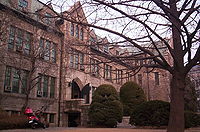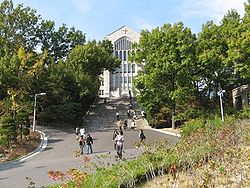Ewha Womans University
 From Nwe
From Nwe 
|
|
| Motto | Truth, Goodness, and Beauty 眞 • 善 • 美 |
|---|---|
| Established | May 31 1886 as Ewha School, college-course installed in 1910, re-established as a university on August 15 1945. |
| Type | Private |
| Location | Seodaemun, Seoul South Korea |
| Website | www.ewha.ac.kr |
Ewha Womans University (Korean: 이화여자대학교, Hanja: 梨花女子大學校), refers to a private women's university in central Seoul, South Korea. One of the city's largest institutions of higher learning, the world's largest female educational institute, Ewha ranks with the best-known universities in South Korea, and the top women's university. Mary F. Scranton, a Methodist Episcopal missionary from the United States, founded Ewha in 1886. The pear blossom represents the school flower, a Sino-Korean term for the school's name. While "Womans" seems grammatical mistake in the name, in the late nineteenth century, at the time of the university's founding, "womans" (as opposed to women's or woman's) constituted the correct English spelling.
Methodist Missionaries Mary Scranton, and Henry G. and Ella D. Appenzeller, established Ewha Hakdang and brother school, Paichai Hakdang, in 1886. Evangelical Protestant missionaries, they had received an invitation to come to Korea as teachers, not missionaries. Looking at the teacher work as a cover for evangelical work at first, Mary Scranton and the Appenzellers quickly came to see the educational work as essential to transforming Korea into a Christian society. Ewha University, having celebrated its 120th anniversary, has been playing a leading role in bringing Christian values to Korean society through Korean women.
| Ewha Womans University | ||||||||
|---|---|---|---|---|---|---|---|---|
|
History

Ewha Womans University traces its roots back to Mary Scranton's Ihwa Hakdang (also Ewha Hakdang; 이화학당 梨花學堂) mission school for girls, opening with only one student on May 31, 1886.[1] Emperor Gojong bestowed The name, meaning “Pear blossom academy,” the following year. The school began to provide college courses in 1910 and professional courses for women in 1925. Immediately following the liberation of Korea on August 15, 1945, the college received government permission to become a university, the first South Korean university officially organized.
Ewha holds many firsts in Korean history: Korea's first female doctor, Esther Park; Korea's first woman to get a doctoral degree, Helen Kim; the first female Korean lawyer, Lee Tai-young; the first female justice on the Constitutional Court, Jeon Hyo-sook, and the first female prime minister, the incumbent Han Myeong-sook, all graduated from Ewha. The "firsts" arises, in part, from Korea's conservative culture that discouraged many Korean women from attending co-ed universities. Ewha's new motto, "Frontier Ewha," captures the zeal to remain at the vanguard of women's education in Korea.
A Timeline of Key Events for Ewha follows:
-
- 1886 - In May, Mary F. Scranton, an American Methodist missionary, opens Korea's first school for women in her house with a single student. In November, the Methodist mission completes construction of a school building (the former base of Ewha Womans University) in Jeong-dong.
-
- 1887 - King Gojong officially names the school "Ihwa (also Ewha)."
-
- 1910 - College courses begin, the same year Japan annexed Korea.
-
- 1925 - Ewha Women's Professional School opens.
-
- 1935 - The campus moves to its current location.
-
- 1946 - Ewha becomes Ewha Womans University, Korea's first university for women, immediately following Korea's liberation from Japanese colonization
-
- 1950 - Ewha graduate schools open, on the eve of the outbreak of the Korean War.
-
- 1977 - Women's Studies classes begin.
-
- 1984 - The School of Continuing Education opens.
-
- 1996 - Ewha opens its College of Engineering, the first such school in a women's university.
-
- 2001 - Division of International Studies established.
-
- 2006 - Ewha offers inaugural Ewha Global Partnership Program and completes the restoration of Ewha Hakdang.
-
- 2007 - Ewha establishes Scranton College, a specialized undergraduate college incorporating its honors program and the Division of International Studies.
Reputation

Ewha Womans University ranks highly selective in terms of admission. According to the Joongang Daily's ranking of universities in Korea, Ewha Womans University ranked ninth in 2003, and fourteenth in 2004. The university was ranked within the top three in the NCSI (National Consumer Satisfaction Index) University rankings for four consecutive years.
Areas of Specialization
Ewha concentrates in eight specialization areas: Life science, Nanoscience, IT, Design Technology, Women’s studies, Korean Studies, Business Management, and International Studies.
Government and Industory Grants
Life science triggered Ewha's specialization development, representative of the university's eight specialization programs. Winning a 3.5 billion Korean won funding grant in Brain Korea 21 project[2] promoted by the Korean Ministry of Education and Human Resources Development brought Ewha into national prominence. Ewha's life science program received funding of 9.9 billion Korean won from the Ministry of Science and Technology. Ewha's cooperation with industry has been vigorous, earning funding of nine billion Korean Won from SK Corporation[3] over a three year period and five billion Korean Won grant from LF, a life science startup, over five years.
Ewha's Nanoscience program won the spot in the Ewha specialization project in 2003. The university established the Division of Nanoscience, the graduate school, in the same year. The Nanoscience program achieved excellent performance in a short period in industry-academia cooperation with fifteen companies such as Amorepacific, Leadgene, Scinco, and Bipolymed. Life Science and Nanoscience have noted as departments of strength in engineering and natural science programs.
Scholarship and Research Patents
Ewha's life science recorded the highest Impact Factor, a quantitative measure of the frequency with which the "average article" published in a given scholarly journal has been cited in a particular year or period, in Korea. Ewha University holds six international patents and thirteen domestic patents.
Organization

The undergraduate departments of Ewha divide into eleven colleges, one division with sixty-five departments. The graduate school offers thirteen programs. A list of the college departments follows:
Undergraduate
- College of Liberal Arts
- College of Social Sciences
- College of Engineering
- College of Natural Sciences
- College of Arts (Music/Fine Arts/Design)
- College of Law
- College of Pharmacy
- College of Education
- College of Business Administration
- College of Health Sciences
- Scranton College (Honors Program, Division of International Studies)
Scranton College opened its doors on March 1, 2007. The College was named after Mary F. Scranton, the missionary who founded Ewha 120 years ago. As a unique program that stands at the core of ‘Global Ewha 2010 Project,’ Scranton College is designed to educate students and enable them to become effective leaders in a globalized world. There are two main programs in the College: the Scranton Honors Program which encompasses a multitude of disciplines, and the Division of International Studies which is specifically aimed at equipping students with the capacity to compete in the global arena.
The Division of International Studies (DIS) was first established in March 2001 as an undergraduate program where English is the language of instruction. It was the first-of-its-kind to be established in Korea. Now, as part of Scranton College, DIS provides individualized curricula for the students in order to help them gain international expertise in their area of choice.
Graduate
- The Graduate School
- The Graduate School of International Studies
- The Graduate School of Translation and Interpretation
- The Graduate School of Social Welfare
- The Graduate School of Business
- The Graduate School of Medicine
- The Graduate School of Education
- The Graduate School of Design
- The Graduate School of Theology
- The Graduate School of Policy Sciences
- The Graduate School of Music in Modern Media
- The Graduate School of Clinical Health Sciences
- The Graduate School of Clinical Dentistry
Notable alumni
- Yu Gwan-sun—Leader of March 1st Movement
- Bang Jee Young – Pianist
- Han Myung-Sook - Prime Minister of South Korea
- Grace Park - LPGA golfer
- Yuko Fueki - Japan and Korea-based actress
Notes
- ↑ Lee Jeong-kyu, The establishment of modern universities in Korea and their implications for Korean education policies Education Policy Analysis Archives 9(27) (2001).
- ↑ Brain Korea 21 Retrieved January 14, 2008.
- ↑ SK Energy Retrieved January 14, 2008.
References
ISBN links support NWE through referral fees
- Choi, Jun Gui. "The internationalization of higher education the case of Korean universities." Thesis (Ph. D.), Catholic University of America, 2003. OCLC 62097942
- Chung, Ii Sook. "Implications of Ross Snyder for ministry to students in Ewha Womans University." M.A. (Religion), Northwestern University, 1969. OCLC 71837985
- Ewha Woman's University Museum. "Catalogue," 1900s. Seoul, Korea: The Museum. OCLC 173695335
- Hanʼguk Taehak Kyoyuk Hyŏbŭihoe. Study and life in Korea Korean universities and colleges. Seoul: Korean Council for University Education, 1998. OCLC 39793516
- Kim, Kyunghee. "The status of dance in Korean higher education." Thesis (Ph. D.), Texas Woman's University, 1993. OCLC 36215407
- Klimes, Rudolf E. Korean universities and colleges. New York: Educational Counseling Center, American-Korean Foundation, 1967. OCLC 1340722
External links
All links retrieved August 9, 2017.
- Ewha University Home Page
- Ewha Voice: Ewha University English Language Newspaper
| Association of Christian Universities and Colleges in Asia | |
|---|---|
| Hong Kong | Chung Chi (CUHK) · Hong Kong Baptist · Lingnan |
| Indonesia | Parahyangan Catholic · Petra Christian · Satya Wacana Christian · Kristen Indonesia · Maranatha Christian · Duta Wacana Christian · Soegijapranata Catholic · Pelita Harapan |
| Japan | ICU · Kwansei Gakuin · Meiji Gakuin · Nanzan · Doshisha · Aoyama Gakuin · Momoyama Gakuin · Obirin · Tohoku Gakuin · Seigakuin |
| Korea | Ewha Womans · Sogang · Soongsil · Yonsei · Keimyung · Hannam · Jeonju · Handong Global · Hoseo · Myongji |
| Philippines | Ateneo de Manila · Central Philippine · DLSU-Manila · Philippine Christian · Silliman · TUA · Filamer Christian |
| Taiwan | Fu Jen Catholic · Soochow · Tunghai · Chung Yuan Christian · Providence · St. John's |
| Thailand | Payap · Assumption · CUT · Mission |
Credits
New World Encyclopedia writers and editors rewrote and completed the Wikipedia article in accordance with New World Encyclopedia standards. This article abides by terms of the Creative Commons CC-by-sa 3.0 License (CC-by-sa), which may be used and disseminated with proper attribution. Credit is due under the terms of this license that can reference both the New World Encyclopedia contributors and the selfless volunteer contributors of the Wikimedia Foundation. To cite this article click here for a list of acceptable citing formats.The history of earlier contributions by wikipedians is accessible to researchers here:
- Ewha Womans University history
The history of this article since it was imported to New World Encyclopedia:
- History of "Ewha Womans University"
Note: Some restrictions may apply to use of individual images which are separately licensed.
↧ Download as ZWI file | Last modified: 02/04/2023 08:13:02 | 303 views
☰ Source: https://www.newworldencyclopedia.org/entry/Ewha_Womans_University | License: CC BY-SA 3.0
 ZWI signed:
ZWI signed: KSF
KSF